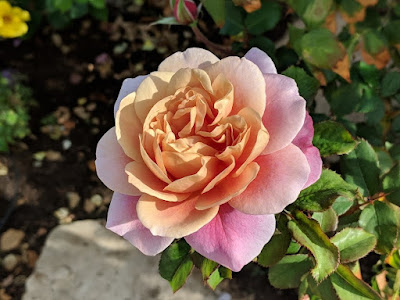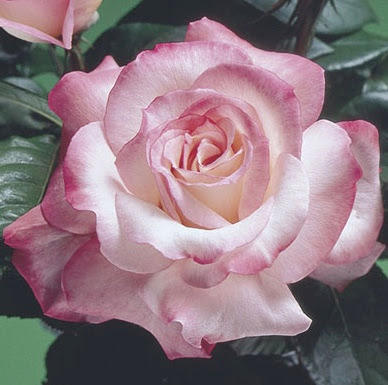
Master rosarian offers her suggestions, shares tips with Farmer Fred

|
|
"Distant Drums" is a winner in Sacramento, says
master rosarian Charlotte Owendyk. (Photos courtesy
Charlotte Owendyk) |
January is the perfect time for pruning roses. It’s also a great opportunity to plant roses.
But which one? There are so many, many rose varieties – more than 30,000 still available in commerce. Is there a “best rose” for Sacramento? For America?
"Farmer Fred" Hoffman, longtime Sacramento gardening expert, posed those questions to Roseville master rosarian Charlotte Owendyk during his latest “Garden Basics with Farmer Fred” podcast. Owendyk, who grows hundreds of roses in her own garden, is well known for her pruning demonstrations and rose talks. During the podcast, she covered some of the pruning pointers from the Sierra Foothills Rose Society’s recent winter rose care workshop.
As for the subject of “best rose,” it depends on who’s growing it and where. Charlotte shared her favorite “bulletproof roses,” varieties that bloom beautifully under a wide range of growing conditions and circumstances – cold winters, hot summers and everything in between.
Her adaptable favorite is an oldie but goody that’s hard to find: 'Distant Drums." Introduced in 1985, it’s a shrub rose with 4-inch blooms that blend orange and purple tones like a Western sunset.
“One rose that can really take the heat and the cold is ‘Distant Drums,’ which has a very distinct coloration,” she says. “The petals are apricot-colored in the center, surrounded by lavender on the outer petals. It’s hardy down to USDA Zone 4, and has a wonderful strong scent with great disease resistance.”
Zone 4 gets down to 0 degrees (or colder); that’s tough!
Her bulletproof floribundas include two old stand-bys: "Iceberg" and "Burgundy Iceberg." They both do well almost anywhere and are a lot easier to find than "Distant Drums." Introduced in 1958, "Iceberg" is ubiquitous in California parking lots; it’s a white rose that can take pollution and still look good. "Burgundy Iceberg" is a purple version of its close cousin.

|
|
"Secret" is a frequent bloomer and very fragrant.
|
“Normally, hybrid tea roses take five or six weeks to rebloom after deadheading,” she says. “For ‘Secret,’ it’s only four to five weeks. That’s why it’s one of my favorite roses. Plus it’s very fragrant.”
Other roses on Charlotte’s bulletproof list include the shrub roses Belinda’s Dream, Lyda Rose and Sally Holmes (which can also be grown as a climber), the floribunda Cinco de Mayo and the hybrid teas Gemini and Memorial Day.
Hear more here: https://gardenbasics.substack.com/p/the-best-roses-for-america-one-master
Also, listen to Fred and Charlotte talk winter rose care during their full podcast, “Prune-ciples: Rose Pruning Tips for Maximum Roses,” at https://www.buzzsprout.com/1004629 .
At that link, you’ll find a full library of Farmer Fred podcasts.
Rather read than listen? Sign up for Farmer Fred’s Garden Basics newsletter: https://gardenbasics.substack.com/ .
Comments
0 comments have been posted.Sacramento Digs Gardening to your inbox.
Food in My Back Yard Series
May 6: Maintain soil moisture with mulch for garden success
April 29: What's (already) wrong with my tomato plants?
April 22: Should you stock up on fertilizer? (Yes!)
April 15: Grow culinary herbs in containers
April 8: When to plant summer vegetables
April 1: Don't be fooled by these garden myths
March 25: Fertilizer tips: How to 'feed' your vegetables for healthy growth
March 18: Time to give vegetable seedlings some more space
March 11: Ways to win the fight against weeds
March 4: Potatoes from the garden
Feb. 25: Plant a fruit tree now -- for later
Feb. 18: How to squeeze more food into less space
Feb. 11: When to plant? Consider staggering your transplants
Feb. 4: Starting in seed starting
Sites We Like
Garden Checklist for week of May 4
Enjoy this spring weather – and get gardening!
* Plant, plant, plant! It’s prime planting season in the Sacramento area. Time to set out those tomato transplants along with peppers and eggplants. Pinch off any flowers on new transplants to make them concentrate on establishing roots instead of setting premature fruit.
* Direct-seed melons, cucumbers, summer squash, corn, radishes, pumpkins and annual herbs such as basil.
* Harvest cabbage, lettuce, peas and green onions.
* In the flower garden, direct-seed sunflowers, cosmos, salvia, zinnias, marigolds, celosia and asters. (You also can transplant seedlings for many of the same flowers.)
* Plant dahlia tubers. Other perennials to set out include verbena, coreopsis, coneflower and astilbe.
* Transplant petunias, marigolds and perennial flowers such as astilbe, columbine, coneflowers, coreopsis, dahlias, rudbeckia and verbena.
* Keep an eye out for slugs, snails, earwigs and aphids that want to dine on tender new growth.
* Feed summer bloomers with a balanced fertilizer.
* For continued bloom, cut off spent flowers on roses as well as other flowering plants.
* Add mulch to the garden to maintain moisture. Mulch also cuts down on weeds. But don’t let it mound around the stems or trunks of trees or shrubs. Leave about a 6-inch to 1-foot circle to avoid crown rot or other problems.